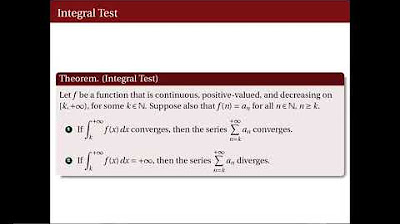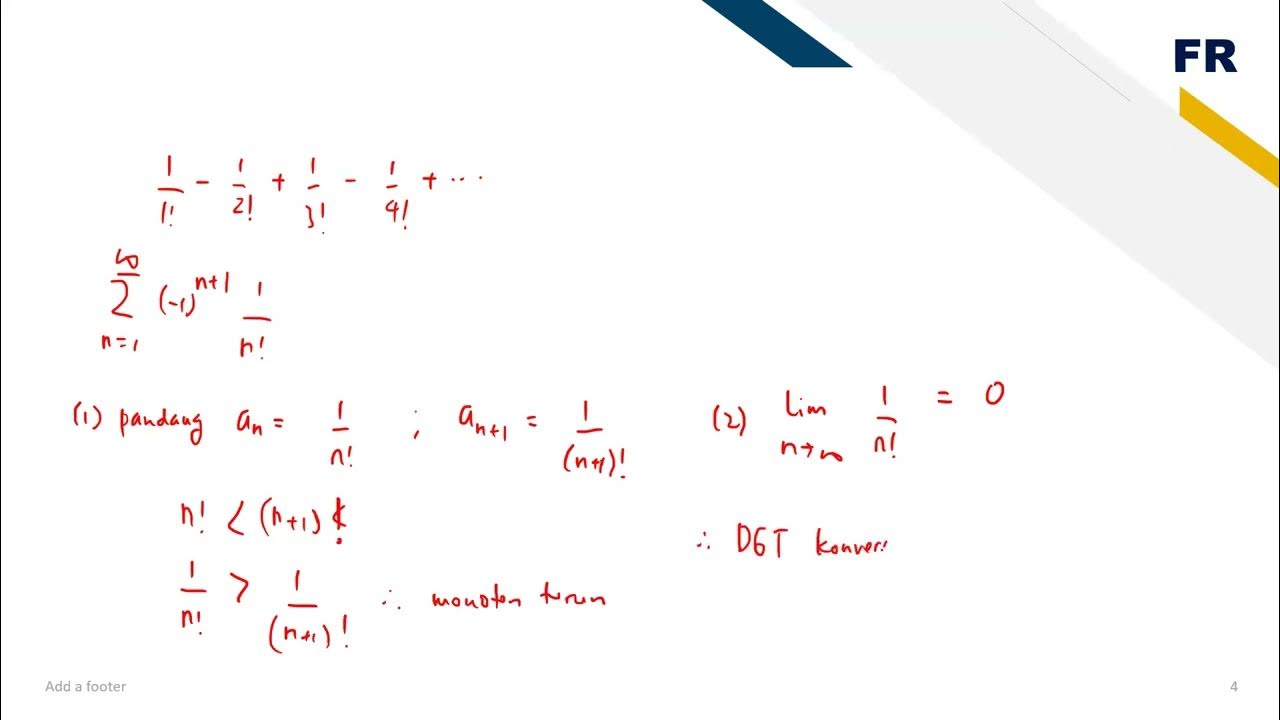3. Числовой ряд. Признак сравнения рядов. Предельный признак сравнения рядов.
Summary
TLDRThis script discusses sufficient criteria for determining the convergence or divergence of series with non-negative terms, often referred to as positive series. It introduces the comparison test, highlighting its application when comparing two series. The script also covers standard series for comparison, such as geometric and harmonic series. Examples are provided to illustrate how to apply the comparison test and the limit comparison test to assess series convergence, emphasizing the importance of recognizing equivalent infinitesimally small quantities.
Takeaways
- 🔢 Non-negative series are those where all terms are greater than or equal to zero.
- 📚 The comparison test is a sufficient condition to determine the convergence or divergence of series with non-negative terms.
- 📐 Standard series used for comparison include geometric progression, harmonic series, and generalized harmonic series.
- 🔄 Multiplying a series by -1 to make it positive does not affect its convergence properties.
- 🔄 The geometric series converges if the absolute value of its common ratio is less than one and diverges otherwise.
- ♾ The harmonic series always diverges.
- 📉 The generalized harmonic series converges if the power of the terms is greater than one and diverges if the power is between zero and one, inclusive.
- 📊 When comparing series, it's beneficial to compare them with series whose behavior (convergence or divergence) is already known.
- 📖 The limit comparison test is used to determine if two series with positive terms converge or diverge simultaneously.
- 📘 Infinitesimal sequences are used to compare series by replacing terms with their equivalents that approach zero.
Q & A
What are the necessary conditions for a series to be considered as having non-negative terms?
-A series is considered to have non-negative terms if for all natural numbers n, the term a_n is greater than or equal to 0.
What is the significance of comparing series with non-negative terms?
-Comparing series with non-negative terms helps in determining the convergence or divergence of the series using sufficient convergence tests.
What is the Comparison Test for series convergence, as described in the script?
-The Comparison Test states that if for all n, the term a_n of series 1 is greater than or equal to the term b_n of series 2, and series 1 converges, then series 2 also converges. Conversely, if series 2 diverges, then series 1 also diverges.
Why is it mentioned that multiplying a series by -1 does not affect its convergence properties?
-Multiplying a series by -1 does not affect its convergence because the properties of convergent series are preserved under scalar multiplication, as long as the scalar is not zero.
What are the standard series used for comparison in the script?
-The standard series used for comparison include the geometric series, harmonic series, and generalized harmonic series.
How does the convergence of a geometric series depend on its common ratio?
-A geometric series converges if the absolute value of its common ratio q is less than 1, and it diverges if the absolute value of q is greater than or equal to 1.
Why is the harmonic series mentioned as always divergent?
-The harmonic series is always divergent because the terms are the reciprocals of natural numbers, which do not decrease fast enough to ensure convergence.
What is the Generalized Harmonic Series, and how does its convergence depend on the power p?
-The Generalized Harmonic Series is a series of the form 1/n^p, where p is a positive real number. The series converges if p > 1 and diverges if p is between 0 and 1, inclusive.
How can you determine if the series 1/log(n) (n starting from 2) converges or diverges?
-By comparing it with the harmonic series using the Comparison Test, it can be shown that since the harmonic series diverges, and 1/log(n) grows slower than 1/n, the given series also diverges.
What is the Limit Comparison Test, and how is it applied in the script?
-The Limit Comparison Test involves finding the limit of the ratio of the corresponding terms of two series as n approaches infinity. If this limit is a non-zero finite number, then both series converge or diverge together. In the script, it is used to compare series with known divergent behavior to determine the convergence of the series in question.
Why is the term 'equivalent infinitesimal sequences' used in the script, and how are they used?
-The term 'equivalent infinitesimal sequences' is used for sequences that become infinitely small as n approaches infinity. They are used to simplify the comparison of series terms by replacing them with simpler functions that behave similarly as n grows large.
Outlines

Dieser Bereich ist nur für Premium-Benutzer verfügbar. Bitte führen Sie ein Upgrade durch, um auf diesen Abschnitt zuzugreifen.
Upgrade durchführenMindmap

Dieser Bereich ist nur für Premium-Benutzer verfügbar. Bitte führen Sie ein Upgrade durch, um auf diesen Abschnitt zuzugreifen.
Upgrade durchführenKeywords

Dieser Bereich ist nur für Premium-Benutzer verfügbar. Bitte führen Sie ein Upgrade durch, um auf diesen Abschnitt zuzugreifen.
Upgrade durchführenHighlights

Dieser Bereich ist nur für Premium-Benutzer verfügbar. Bitte führen Sie ein Upgrade durch, um auf diesen Abschnitt zuzugreifen.
Upgrade durchführenTranscripts

Dieser Bereich ist nur für Premium-Benutzer verfügbar. Bitte führen Sie ein Upgrade durch, um auf diesen Abschnitt zuzugreifen.
Upgrade durchführenWeitere ähnliche Videos ansehen

[Math 22] Lec 08 Integral Test and Comparison Test (Part 1 of 2)

Deret Ganti Tanda, Konvergensi Mutlak dan Konvergensi Bersyarat

Convergence and Divergence - Introduction to Series

Convergence and Divergence: The Return of Sequences and Series

Kalkulus | Barisan dan Deret Tak Hingga (Part 14) - Uji Deret Positif (Uji Integral)

Geometric Series and Geometric Sequences - Basic Introduction
5.0 / 5 (0 votes)
